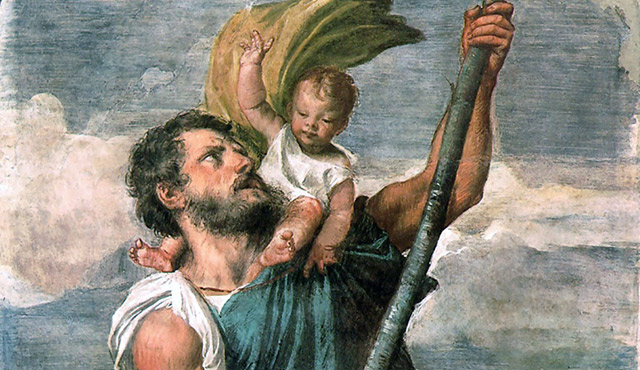When Saint Christopher was officially “demoted” in 1969—and we’ll get back to that word in a minute—it temporarily took a bit of starch out of the many millions of people around the world with Saint Christopher medals around their necks, in their carry-on luggage and on their dashboards. Christopher, after all, was enormously popular and had been for centuries. The patron saint of travelers, his legend was irresistible. The image of him shouldering the boy Jesus and carrying him across a rushing river in safety offered comfort to many a not-so-frequent flyer when the fasten seat belt sign went on.
And then, suddenly, he was crossed off the A-list. Or was he?
What actually happened to Saint Christopher—and to quite a few other saints of the early Church—was not so much a demotion as a reassignment. The confusion arose when Pope Paul VI revised the Liturgical Calendar, which includes the feast days of saints that are commemorated at Mass. Paul was following a mandate of Vatican II contained in the council document Sacrosanctum Concilium, the council’s constitution on the liturgy.
The problem: the calendar was simply too crowded with saints, particularly saints who had local or regional rather than universal followings. The council declared: “Lest the feasts of the saints take precedence over the feasts commemorating the very mysteries of salvation, many of them should be left to be celebrated by a particular Church or nation or religious family; those only should be extended to the universal Church that commemorate saints of truly universal significance” (SC 111).
The council “examined the calendar and removed those saints whose historical base was more grounded on tradition than provable fact, changed the feast days to coincide with the anniversary of a saint’s death or martyrdom whenever possible, and added saints that were recently canonized and had universal Church appeal,” wrote Father William Saunders, the dean of the Notre Dame Graduate School of Christendom College. “Moreover, local conferences of bishops could add to the universal calendar those saints important to the faithful in their own country.”
Though his name disappeared from the revised Liturgical Calendar, as it turns out, the reports of Christopher’s demise were greatly exaggerated. He has never ceased to be recognized as a saint by the Church. His history/legend is telling.
Christopher is one of the saints of Christian antiquity about whom little verifiable information is known. According to Father William, “tradition holds that he died at Lycia on the southern coast of Asia Minor about the year 251. Various legends surround his life. The most popular is that he was a rather ugly, giant man, born to a heathen king who was married to a Christian, who had prayed to the Blessed Mother for a child. Originally named Offerus, he carried people across the river for his livelihood. He converted from paganism through the teaching of a hermit named Babylas. Christopher believed that our Lord was the most powerful of all, more powerful than any man and one whom even Satan feared.”
One day, again according to the legend, Christopher picked up a fairly significant passenger—a small child. “As they proceeded [across the river],” wrote Father William, “the child kept growing heavier and Christopher feared that they would drown. The child then revealed himself as Jesus, and the heaviness was due to the weight of the world that he carried on his shoulders.”
The saint’s name means “Christ-bearer”.
Christopher was a tough cookie until the end: according to the Roman Martyrology, he was executed during the reign of Emperor Decius by being shot with arrows after surviving burning.
His popularity increased in the Middle Ages, and he enjoyed particular devotion in southern Germany, Austria and northern Italy as one of the “14 Holy Helpers”: a group of saints who are honored in that part of the world on August 8.
Christopher’s individual feast day, however, continues to be celebrated on July 25.
One man who celebrates that day with enthusiasm is Father Christopher Smith, the rector of Christ Cathedral. Disappointed briefly during high school in 1969 when he believed his namesake had been “de-sainted,” Father Christopher says that he felt better after entering the seminary and learning that Christopher had simply been shunted off the official calendar.
“I never lost devotion to Christopher because his story is so beautiful,” he says. “To me, he’s always been one of the most evangelizing saints because Catholics, non-Catholics and even non-Christians have a certain devotion to Christopher. And he’s very popular in the surfing culture.”
He recalled a popular custom among Southern California junior high and high school students that involved exchanging colorful enamelled Saint Christopher medals as tokens of affection between boys and girls.
“I remember it as if it were yesterday,” said Father Christopher. “It was a big deal to get one. We used to call it just a Christopher. And the colors were so beautiful.”
He doesn’t have his old medal from his high school days, but Father Christopher wears an updated version daily.
“Mine is more like a sculpture,” says Father Christopher, “and on the back—I’ve always thought this is ironic—is an engraving that says, ‘I am a Catholic. In case of an accident, please call a priest.’”

